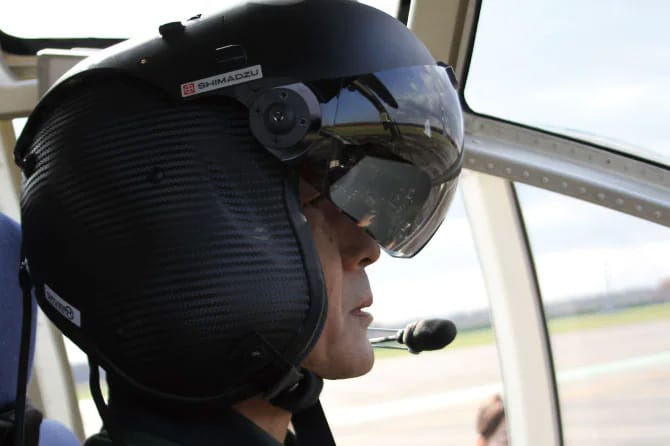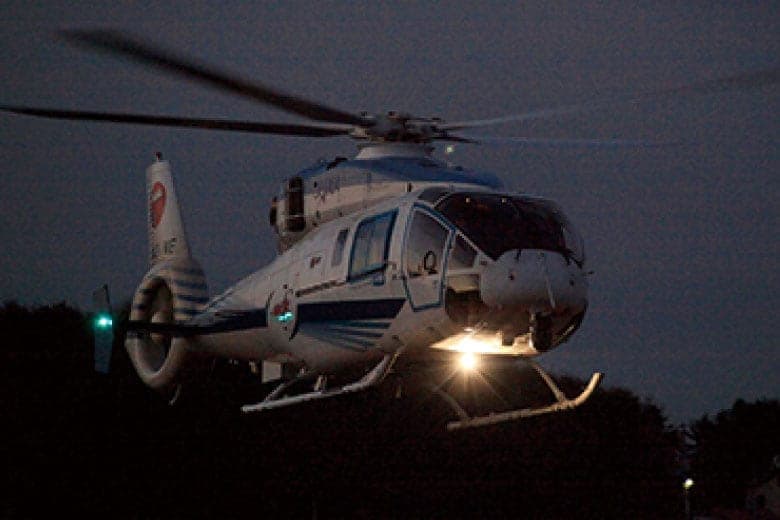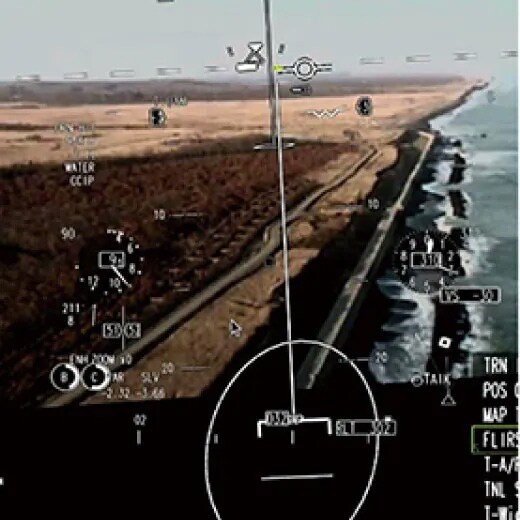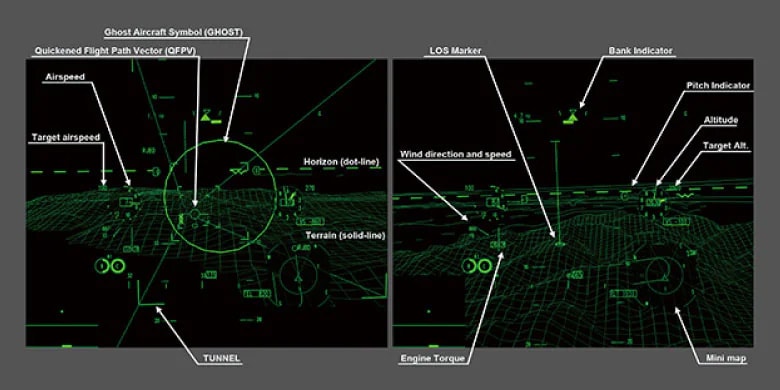New eyes for aircraft pilots


Series: MOMENTUM
Pilots of a particular type of aircraft have a helmet mounted display (HMD) installed in their visors. Shimadzu Corporation and Japan Aerospace Exploration Agency (JAXA) are now coordinating their research to apply this technology effectively to disaster relief efforts.
The HMD detects head movements, so the pilot can acquire all the information they need regardless of what direction they are facing. A range of information is projected on the display, including flight data, route guidance, and 3D terrain. Furthermore, thanks to an infrared camera, the images viewed remain clear regardless of weather conditions or the time of day or night. The product can be said to provide pilots with a new pair of eyes, since they can acquire necessary information by simply looking outside.
There has been a heightened consciousness of disasters in Japan in the wake of the Great East Japan Earthquake of March 2011. In this social context, a great deal of attention is focused on the role of rescue helicopters. The HMD is expected to play a larger role in rescue missions in the future, improving the potential to save lives, as well as aiding fire-fighting activities.

Flight test at night
How HMD may help save lives
The Shimadzu HMD is already used on the US-2 search and rescue amphibian plane, which is important for rescue efforts at sea. Shimadzu is the only company in the world to provide HMD for search and rescue use.
At the same time, effective use of helicopters is also crucial for lifesaving efforts, such as searches in mountainous regions and emergency transport on outlying islands. These services are often in particularly high demand in conditions where the weather is bad and the visibility is low. Ensuring safety is the priority, and to this aim, improving the situational awareness (SA) of pilots is important.
Utilizing information obtained from sensors on the aircraft and from databases, and then, using the HMD to present pilots with details of the external field of view and the location and position of other the aircraft, all contribute to improving pilot SA.
The most important objective of search and rescue helicopters is to find people as quickly as possible. For this, two things are essential. The first is to free pilots from looking at flight instruments, thereby increasing the amount of time spent visually searching for survivors. The second is to be able to see the outside world clearly even in bad weather or at night. HMD gives pilots more time and a clearer field of view to find survivors, and thus boosts lifesaving opportunities.

Guidance for fire fighting showing optimal flight approach and water release timing
Our new project: SAVERH
Since 2009, research has been conducted in collaboration with JAXA on a project called Situational Awareness and Visual Enhancer for Rescue Helicopter (SAVERH), based on the technology developed for the US-2 search and rescue amphibian plane. SAVERH presents pilots with effective visual information that supports search and rescue missions. The objectives are to use HMD to support flight handling under low visibility conditions, and at the same time, to remember the position of survivors when they are spotted, so that they can be found again if pilots lose sight of them.
If this project is extended, it could also be applied to fighting bush fires, for example. The cooperative research has been conducted with JAXA and ShinMaywa Industries, Ltd. In aerial firefighting efforts, the amount of water that a helicopter can carry is limited, so it is important to increase the efficiency with which fires are extinguished with each flight. The trajectory of water released during the flight is calculated by computer, based on a variety of factors including the aircraft speed, location and position, as well as the power and direction of the wind. The efficiency of aerial firefighting can then be enhanced by using the HMD to guide pilots as to the optimal flight approach and water release timing for the most efficient fire-fighting.
Within the SAVERH project, we are currently performing flight tests at night in mountainous and coastal areas. The HMD, infrared cameras and display system have all proved successful in terms of basic operations and validity checks. Continued flight tests will help to improve the display systems further. At present, helicopter flights under low visibility conditions are restricted by regulations. We plan to attempt to initiate legislative reforms, in order to promote the practical use of HMD.

HMD indicating route guidance and marker tracking
The Shimadzu HMD and our contribution to society
It has been over 20 years since Shimadzu began research and development on HMD, and we will continue to expand this technology to develop cockpit display systems that are more efficient and user-friendly. By challenging ourselves in areas like this where the technology is relatively undeveloped we aim to meet certain societal needs. Our hope is that HMD will make significant contributions to lifesaving and disaster prevention, in line with our corporate philosophy since Shimadzu's inception: "Contributing to Society through Science & Technology". While work at the Shimadzu Aircraft Equipment Division is demanding, we remain intent on consistently developing new products like this, and thereby helping people, and enhancing their quality of life.
* This article was originally published on MOMENTUM Vol. 01, 2014.
 Copied
Copied

